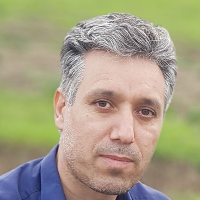The Influence of Ultrasound and Growth Regulators on in vitro Micropropagation of Lilium Ledebourii Boiss
Author(s):
Article Type:
Research/Original Article (دارای رتبه معتبر)
Abstract:
Background and Objectives Lilium ledebourii is one of the wild species of Lilium genus, growing in northern Iran. This species has high potential for export. Plant tissue culture techniques are widely used in plant propagation, and using these methods can effectively provide micro-propagation of this plant in the large scale. High percentage of regeneration is necessary for plant protection, used in the breeding programs.
Materials and Methods The experiment was factorial based on completely randomized design with four replications and was carried out in tissue culture Lab of Mohaghegh Ardabili University in 2015. For this purpose, segments of explant that were treated with ultrasound were cultured on MS medium supplemented with different concentrations of NAA and BA alone and/or in combination with each other. This experiment conducted Concentrations of NAA at four level Zero, 0.01, 0.1 and 1 mgl-1 and Concentrations of BAP at four levels Zero, 0.01, 0.1 and 1 mgl-1 and Ultrasound at four levels zero, 5, 10, 20 and 30 seconds. In order to remove possible contamination from the mediums, all media were autoclaved for 30 minutes at 121 °C. At the end of the experiment, the number of bulblet produced, root length, fresh weight of bulblet and etc were recorded. The cultures were kept at 20°C or 25°C under 16 h photoperiod or in darkness.
Results The results showed the highest number of bulblets produced in 0, 0.01, 0.1 mg L-1 NAA and 5secend ultrasound, 0.1 mg L-1 NAA and 0, 5, 20 and 30 second ultrasound compared with control. The highest frequency of bulblet regeneration was produced in MS medium supplemented with 0, 0.01, 0.1 mg L-1 NAA and 5 second ultrasound. On the other hand, 0.1 mg L-1 NAA and 5 second ultrasound increased number and weight of bulblets. Different concentrations of NAA had also significant effects.
Discussion On the other hand, ultrasound increased the number and weight of bulblets. Mechanical stress and micro streaming by acoustic cavitation might be considered as the most possible cause of the various physiological effects of ultrasound on cells. Low-energy ultrasound can modify cellular metabolisms or facilitate the uptake of nutrient, and make them easily through the cellular walls and membranes. Finally, it seems that ultrasound in combination with growth regulators have the potential to produce the highest average number of bulblets in the scale explant, using plant growth regulators in combination with an abiotic stress in in vitro.
Materials and Methods The experiment was factorial based on completely randomized design with four replications and was carried out in tissue culture Lab of Mohaghegh Ardabili University in 2015. For this purpose, segments of explant that were treated with ultrasound were cultured on MS medium supplemented with different concentrations of NAA and BA alone and/or in combination with each other. This experiment conducted Concentrations of NAA at four level Zero, 0.01, 0.1 and 1 mgl-1 and Concentrations of BAP at four levels Zero, 0.01, 0.1 and 1 mgl-1 and Ultrasound at four levels zero, 5, 10, 20 and 30 seconds. In order to remove possible contamination from the mediums, all media were autoclaved for 30 minutes at 121 °C. At the end of the experiment, the number of bulblet produced, root length, fresh weight of bulblet and etc were recorded. The cultures were kept at 20°C or 25°C under 16 h photoperiod or in darkness.
Results The results showed the highest number of bulblets produced in 0, 0.01, 0.1 mg L-1 NAA and 5secend ultrasound, 0.1 mg L-1 NAA and 0, 5, 20 and 30 second ultrasound compared with control. The highest frequency of bulblet regeneration was produced in MS medium supplemented with 0, 0.01, 0.1 mg L-1 NAA and 5 second ultrasound. On the other hand, 0.1 mg L-1 NAA and 5 second ultrasound increased number and weight of bulblets. Different concentrations of NAA had also significant effects.
Discussion On the other hand, ultrasound increased the number and weight of bulblets. Mechanical stress and micro streaming by acoustic cavitation might be considered as the most possible cause of the various physiological effects of ultrasound on cells. Low-energy ultrasound can modify cellular metabolisms or facilitate the uptake of nutrient, and make them easily through the cellular walls and membranes. Finally, it seems that ultrasound in combination with growth regulators have the potential to produce the highest average number of bulblets in the scale explant, using plant growth regulators in combination with an abiotic stress in in vitro.
Keywords:
Bulblet , Explant , Hormonal combination , In vitro , Scale
Language:
Persian
Published:
Plant Production, Volume:40 Issue: 4, 2018
Pages:
11 to 20
magiran.com/p1834310
دانلود و مطالعه متن این مقاله با یکی از روشهای زیر امکان پذیر است:
اشتراک شخصی
با عضویت و پرداخت آنلاین حق اشتراک یکساله به مبلغ 1,390,000ريال میتوانید 70 عنوان مطلب دانلود کنید!
اشتراک سازمانی
به کتابخانه دانشگاه یا محل کار خود پیشنهاد کنید تا اشتراک سازمانی این پایگاه را برای دسترسی نامحدود همه کاربران به متن مطالب تهیه نمایند!
توجه!
- حق عضویت دریافتی صرف حمایت از نشریات عضو و نگهداری، تکمیل و توسعه مگیران میشود.
- پرداخت حق اشتراک و دانلود مقالات اجازه بازنشر آن در سایر رسانههای چاپی و دیجیتال را به کاربر نمیدهد.
دسترسی سراسری کاربران دانشگاه پیام نور!
اعضای هیئت علمی و دانشجویان دانشگاه پیام نور در سراسر کشور، در صورت ثبت نام با ایمیل دانشگاهی، تا پایان فروردین ماه 1403 به مقالات سایت دسترسی خواهند داشت!
In order to view content subscription is required
Personal subscription
Subscribe magiran.com for 70 € euros via PayPal and download 70 articles during a year.
Organization subscription
Please contact us to subscribe your university or library for unlimited access!



